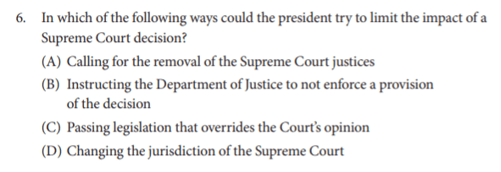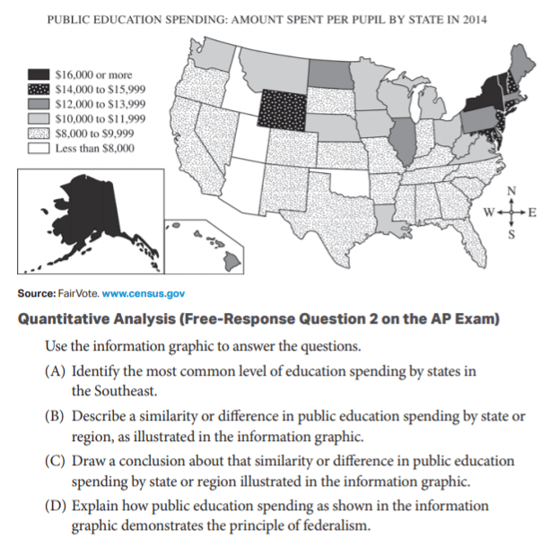
AP US Government can be a fascinating class for students who are interested in how the American political system works and what factors led to its formation. While the exam is less difficult than many other AP exams, it's still important that you understand the types of questions and the most efficient ways to study for AP Government.
In this extensive AP Gov review guide, we'll go through sample test questions, list a step-by-step AP Government review process, and give you tips for making the most of your prep.
What's the Format of the AP US Government Exam?
The AP Government exam is three hours long, and, like other AP exams, includes both a multiple-choice section and a free-response section. Each section counts for 50% of your total score.
Here's a quick overview of the AP Gov exam:
| Section | % of Score | Time | # of Questions | Question Types |
| Multiple Choice | 50% | 1 hr 20 mins | 55 |
|
| Free Response | 50% | 1 hr 40 mins | 4 |
|
| TOTAL | 100% | 3 hrs | 59 | — |
The multiple-choice section comes first and is one hour and 20 minutes long. There are 55 questions, including set-based questions and about 30 individual questions. Every question has four possible answer choices (A-D).
You get 1 point for each question you answer correctly; no points are deducted for any incorrect answers or questions left blank.
There are three types of set-based questions:
- Quantitative Analysis (five sets, two to three questions per set)
- Qualitative Analysis (two sets, three to four questions per set)
- Visual Analysis (three sets, two questions per set)
The free-response section is slightly longer at one hour and 40 minutes. It has four questions, and each question is worth 12.5% of your final score (note that the number of raw points you'll get for each question differs slightly, but this doesn't change the fact that they're all worth the same amount, percentage-wise).
Here are the four free-response question types:
- Concept Application (3 points, recommended 20 minutes)
- Quantitative Analysis (4 points, recommended 20 minutes)
- SCOTUS Comparison (4 points, recommended 20 minutes)
- Argument Essay (6 points, recommended 40 minutes)
AP Gov Review: What Do Questions Look Like?
Here, we'll look at official examples of questions from each section of the test. Both sample questions come from the 2019-20 AP US Government and Politics Course and Exam Description.
Multiple-Choice Question Example

To be able to answer this multiple-choice question, you'll need to understand the relationship between the president and the Supreme Court. This includes knowing how Supreme Court decisions are made and enforced.
Answer choice A doesn't make sense because the president cannot just remove a Supreme Court justice. To remove one, the justice would have to be impeached and charged with a crime.
Choice B is plausible since the Department of Justice is what enforces legislation, so let's keep that for now.
Answer choice C doesn't work because the president doesn't have the power to pass legislation. A proposed law would need to pass Congress first before being presented to the president.
Finally, choice D is wrong because only Congress—not the president—can change the jurisdiction of the Supreme Court; this is laid out clearly in the Constitution.
As a result, we know that answer choice B must be the correct answer.
Free-Response Question Example

This free-response example takes the form of the second question (the Quantitative Analysis one) you'll get on the second section of the AP US Gov exam. With this question type, you will need to interpret and analyze a piece of visual data, such as a chart, line graph, table, or map. Like all free-response questions, this is worth 12.5% of your final score.
For this sample question specifically, you must complete four tasks (A-D), all of which have to do with the map showing public education spending per student in every state in 2014.
Here's what you're being assessed on with this question, according to the current AP Government Exam Description:
This question assesses students' ability to perform the following:
- Describe the data presented
- Describe a pattern, trend, similarity, or difference in the data presented
- Draw a conclusion based on the data
- Explain how the data demonstrate a political principle, institution, process, policy, or behavior
What Topics Does the AP US Government Exam Cover?
There are five major units in the AP Gov course that are covered by the exam. Here is a chart detailing approximately what percentage of the multiple-choice section each unit makes up on the AP test:
| Unit (Topic Area) | % of Questions |
| Unit 1: Foundations of American Democracy | 15-22% |
| Unit 2: Interactions Among Branches of Government | 25-36% |
| Unit 3: Civil Liberties and Civil Rights | 13-18% |
| Unit 4: American Political Ideologies and Beliefs | 10-15% |
| Unit 5: Political Participation | 20-27% |
AP Government Review: 5 Steps to Prepping for the Exam
It can be hard to know where to start with your AP Gov exam review. Here, we'll walk you through five steps to get you ready for the exam.
Here's an approximate timeline for the completion of all five steps:
- Step 1: 3 hours
- Step 2: 1 hour
- Step 3: 2 hours
- Step 4: 2 hours
- Step 5: 3 hours
Total Time: 11 hours
Step 1: Take a Practice Test
The first step in your AP Gov review should be to take a real practice exam. You need to do this before you dive into studying so you can focus on the areas that need the most work rather than reading over the material indiscriminately. As mentioned in the previous section, you should also be sure to time yourself accurately on this practice test.
Here are six full-length, official practice tests you can use in your AP Government review:
- 2018 Practice Test
- 2013 Practice Test
- 2012 Practice Test
- 2009 Practice Test
- 2005 Practice Test
- 1999 Practice Test
It's a good idea to prioritize the 2018 test, as this one is more in line with what you'll see on the 2020 test. The other ones all use an older format, so you might be better off digging into them for individual practice questions.
When you're done with your test, score it using the answer guide at the end. For the free-response questions, consult the official scoring guidelines.
This should give you some insight into how much time you'll need to spend studying if you want to reach your goals. The AP US Government exam is known as one of the easier AP tests, so I'd suggest that you aim for a 5 unless you're really struggling with the material.
Step 2: Look Back at Your Mistakes
Once you've finished scoring your test, review your mistakes to see which topics need to be addressed in your studying. Categorize incorrect answers by topic area and/or skill set. If you find that you had a lot of trouble with questions that asked about the judiciary, for example, you'd want to focus on that content in your AP Government and Politics content review.
You can also consider the types of question formats that tripped you up most frequently. For instance, if you noticed that you did especially poorly on passage-based questions, you might conclude that you need to practice digesting the information in the passages better before trying to answer the questions that accompany them.
Step 3: Study Whatever You Forgot
After you've reviewed your mistakes, dive back into your AP Gov review notes and study any content that was problematic for you on the practice test.
If you don't have many issues with content and are struggling more with the test format or careless mistakes, you can just do a short review of any small tidbits you missed before moving on to the next step.
Step 4: Do Individual Practice Questions
This step is important if most of your mistakes came from careless misunderstandings of the questions. Practice similar questions so that you can get more used to the wording and formats of questions on the exam.
You'll find official practice questions in the AP Government Course and Exam Description, on the College Board website (free-response questions only), and in AP Classroom. You can also look for high-quality unofficial questions in top-rated AP Gov exam review books.
Step 5: Take a Second Practice Test to Measure Your Progress
When you're pretty sure you have a better handle on all the issues that plagued you on the first AP US Government practice test, it's time to take another practice test to see whether you've made any progress. Again, make sure to time the test accurately and take it in a quiet place free of distractions.
If you find that your scores have improved, you can either decide that you're satisfied or shoot for even more improvement by going through this five-step process again. If you don't see much improvement, you should backtrack and reexamine your study process. It might be that you were reading over your notes without really absorbing them, or you didn't do enough practice questions to really get the hang of the test.

When you finish your AP Government review, the unofficial Step 6 is to convince your teacher to let you watch House of Cards in class for the remainder of the year.
3 Essential Study Tips for Your AP Gov Exam Review
Finally, here are a few essential study tips to keep you on track during your AP Government review.
#1: Prioritize Unit 2 Concepts
As we showed you in the chart above, Unit 2 ("Interactions Among Branches of Government") is the biggest topic, accounting for about one-third of the test. Congress, the Supreme Court, the president, and the Constitution, in particular, are hot topics.
You should be familiar with the powers of these different institutions, their compositions, and, most importantly, what kind of relationship they have with one another. Think about how these powers are balanced, too.
It's critical to have this knowledge as a foundation so that all the other information you've learned makes sense and can be tied back to the central structure of the US political system.
#2: Learn Key Terms
AP US Government places a lot of emphasis on understanding terms in context and identifying correct definitions on both sections of the test. It's a great idea to make some flashcards to get yourself up to speed with all the fancy words used to describe stuff related to the government.
Most AP Gov review books and textbooks will have lists of key vocabulary words you can reference when creating flashcards. Be able to identify each term by its corresponding definition and state the definition when presented with a particular term.
#3: Use Authentic Practice Resources
There's no foolproof substitute for official AP practice questions when reviewing for this test. Although it's fine to use some unofficial sources (and, in fact, you will probably have to if you hope to get in enough practice!), you need to mix in at least some official questions to make sure you're truly ready for the exam.
Take at least one or two official AP US Government practice tests so you can get an accurate prediction of how you're likely to perform on the real test.
You should also time yourself to the specifications of the real AP test when taking these practice tests. This will help you determine whether you have any issues with time management and allow you to hone your pacing skills.
You have about a minute and a half for each multiple-choice question (remember that you'll have to answer 55 questions in 80 minutes), so make it a habit to keep moving forward. This way, you can ensure you make it to the end of the section.

Don't get stuck in traffic when you come across hard questions. Either take your best guess or skip it on the first run through and come back to it later. Make sure you glare at the question as you zoom past. It knows what it did.
Key Takeaways: What to Do in Your AP Government Review
The AP US Government and Politics exam covers a wide range of topics and includes some tricky question types you should get familiar with before test day.
Here's a recap of the steps you will need to take to get the most out of your AP Gov review:
#1: Take a practice test
#2: Look back at your mistakes
#3: Study what you missed
#4: Do individual practice questions
#5: Take another practice test
You can repeat these steps as necessary until you're satisfied with your scores.
In your studying, focus on learning the ins and outs of institutions of national government and memorizing the definitions of key terms. You should also practice your skills using real AP questions from the College Board website.
Above all, don't be intimidated by this test. You're almost certainly capable of earning a 5 if you start studying well in advance!
What's Next?
To get your studying started, here's an article detailing how to find the best AP practice exams. In addition, take a look at our complete guide to AP US Gov free-response questions.
Want even more advice on how to do well on your AP exams? Check out these six critical tips for success on any AP test.
If your school doesn't offer the specific AP class you want to take, you might consider going rogue and taking the test anyway. Learn how you can self-study for an AP exam and still get a great score.
Have friends who also need help with test prep? Share this article!

Samantha is a blog content writer for PrepScholar. Her goal is to help students adopt a less stressful view of standardized testing and other academic challenges through her articles. Samantha is also passionate about art and graduated with honors from Dartmouth College as a Studio Art major in 2014. In high school, she earned a 2400 on the SAT, 5's on all seven of her AP tests, and was named a National Merit Scholar.



































 Holly R.
Holly R.